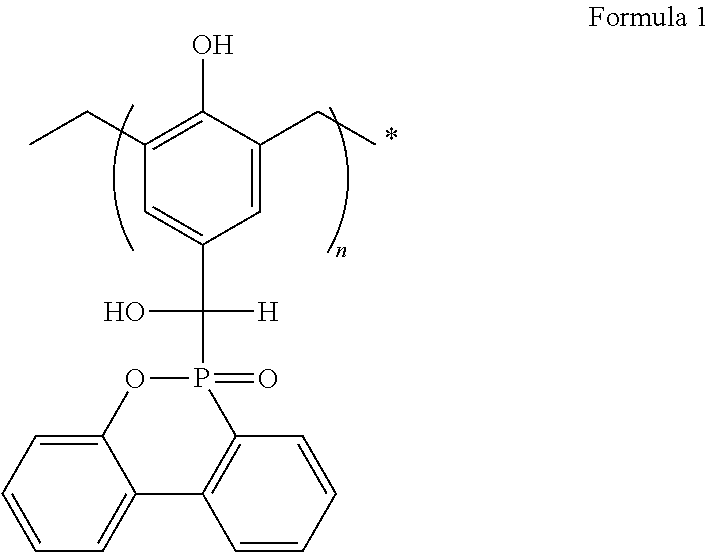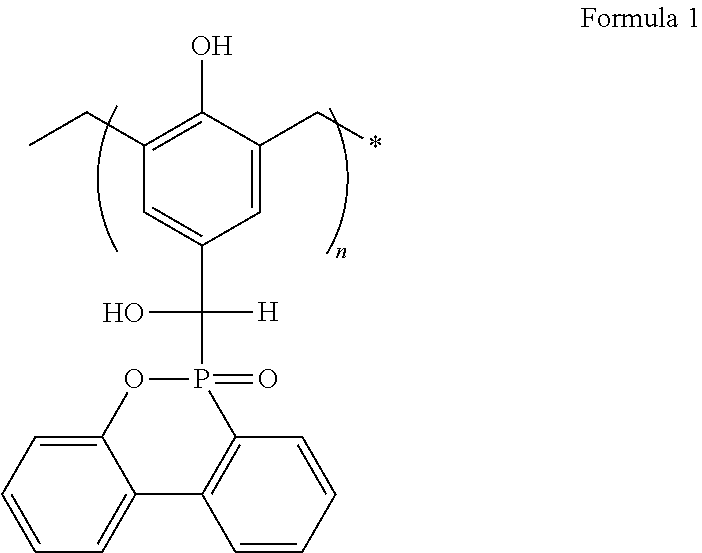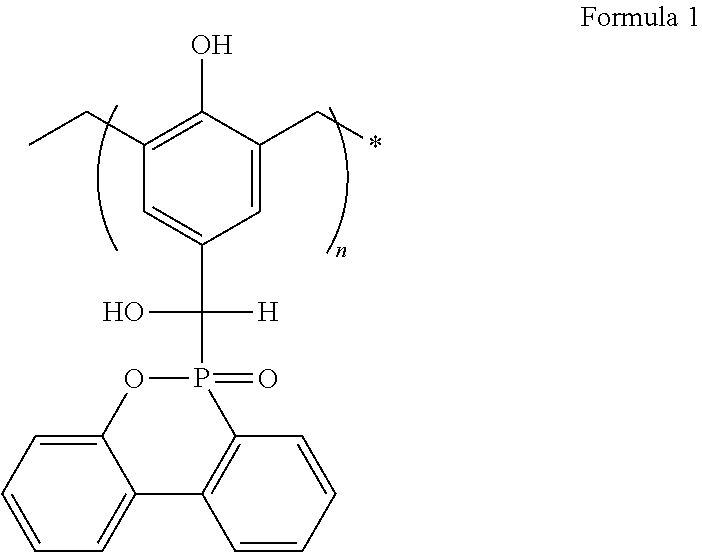Phosphorus-containing phenol novolac resin, hardener comprising the same and epoxy resin composition
a technology of phenol novolac resin and hardener, which is applied in the direction of organic chemistry, chemical apparatus and processes, and group 5/15 element organic compounds. it can solve the problems of deterioration of copper clad laminate properties, metal corrosion, harmful to the human body, etc., and achieve the flame retardancy easily achieved effect of increasing phosphorus conten
- Summary
- Abstract
- Description
- Claims
- Application Information
AI Technical Summary
Benefits of technology
Problems solved by technology
Method used
Image
Examples
example 1
[0059](1) Synthesis'of DOPO-HB
[0060]A nucleophilic addition reaction between the —P(O)—H group which is a nucleophile and the C═O group which is an electrophile present in aldehydes or ketones is well known. Using this reaction, DOPO and 4-hydroxybenzaldehyde were reacted together, thus synthesizing DOPO-HB having both —OH group and a phosphorus component (Reaction 1).
[0061]Specifically, DOPO (216 g, 1 mol, available from Schill & Seilacher) and 4-hydroxybenzaldehyde (134 g, 1.1 mol, available from Aldrich) were added to toluene (1,000 ml) and well dissolved therein.
[0062]This reaction mixture was heated to reflux at 120° C. for 5 hours, cooled to room temperature, washed with toluene, and then recrystallized in methanol, thus obtaining a product.
[0063]Yield: 95%
[0064]Melting point: 241° C.
[0065]NMR (300 MHz, DMSO-d6) δ 5.01 (1H, dd, J=5.7, 6.0 Hz), 5.18 (1H, t, J=11.3 Hz)., 6.14-6.30 (1H, m), 6.66-8.20 (12H, m), 9.45 (1H, d, J=14.5 Hz)
[0066](2) Synthesis of DOPO-PN
[0067]DOPO-PN was...
example 2
[0074]DOPO-PN was synthesized in the same manner as in Example 1, with the exception that DOPO-HB (101.56 g, 0.3 mol) and formaldehyde (8.10 g, 0.24 mol) were used in (2).
[0075]The product thus obtained had a softening point of 94° C., a phosphorus content of 8.8%, and a weight average molecular weight of 1,024.
example 3
[0076]DOPO-PN was synthesized in the same manner as in Example 1, with the exception that DOPO-HB (101.56 g, 0.3 mol) and formaldehyde (8.60 g, 0.255 mol) were used.
[0077]The product thus obtained had a softening point of 108° C., a phosphorus content of 8.71, and a weight average molecular weight of 1,870.
[0078]Test Example: Evaluation of Solubility in Solvent
[0079]The DOPO-PN of Example 1 was measured for solubility in various solvents. The results are shown in Table 1 below.
[0080]The solubility in various solvents was measured by mixing the resin and the solvent at a weight ratio of 50:50, dissolving this mixture at 50° C. for 2 hours, transferring the completely dissolved solution into a 100 ml vial, storing it at room temperature (25° C.) for 24 hours, and after 24 hours, observing with the naked eye whether a white residue, a precipitate, or an insoluble portion remained in solution.
TABLE 1SolventSolubilityEx. 12-MethoxyethanolGood1-Methoxy-2-PropanolGoodMethylethylketonePoorD...
PUM
| Property | Measurement | Unit |
|---|---|---|
| Glass transition temperature | aaaaa | aaaaa |
| Softening point | aaaaa | aaaaa |
| Temperature | aaaaa | aaaaa |
Abstract
Description
Claims
Application Information
 Login to View More
Login to View More - R&D
- Intellectual Property
- Life Sciences
- Materials
- Tech Scout
- Unparalleled Data Quality
- Higher Quality Content
- 60% Fewer Hallucinations
Browse by: Latest US Patents, China's latest patents, Technical Efficacy Thesaurus, Application Domain, Technology Topic, Popular Technical Reports.
© 2025 PatSnap. All rights reserved.Legal|Privacy policy|Modern Slavery Act Transparency Statement|Sitemap|About US| Contact US: help@patsnap.com



